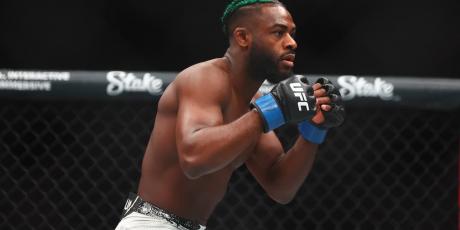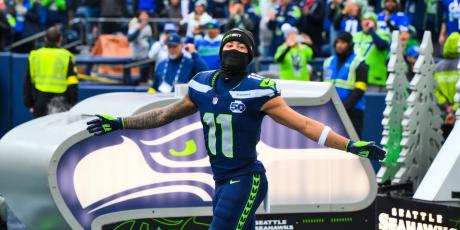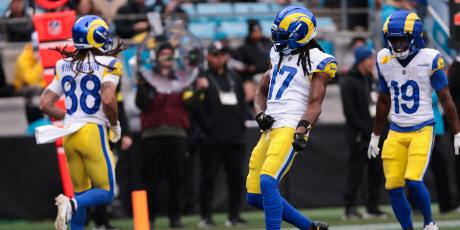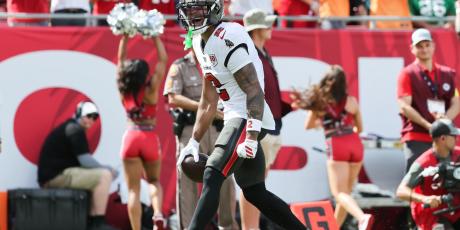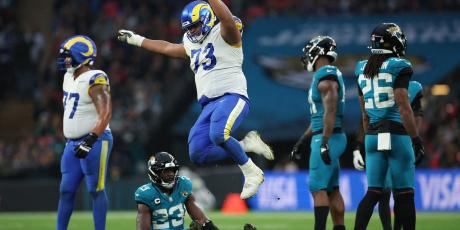A First Look at Best-Ball ADP: MFL10 vs DRAFT
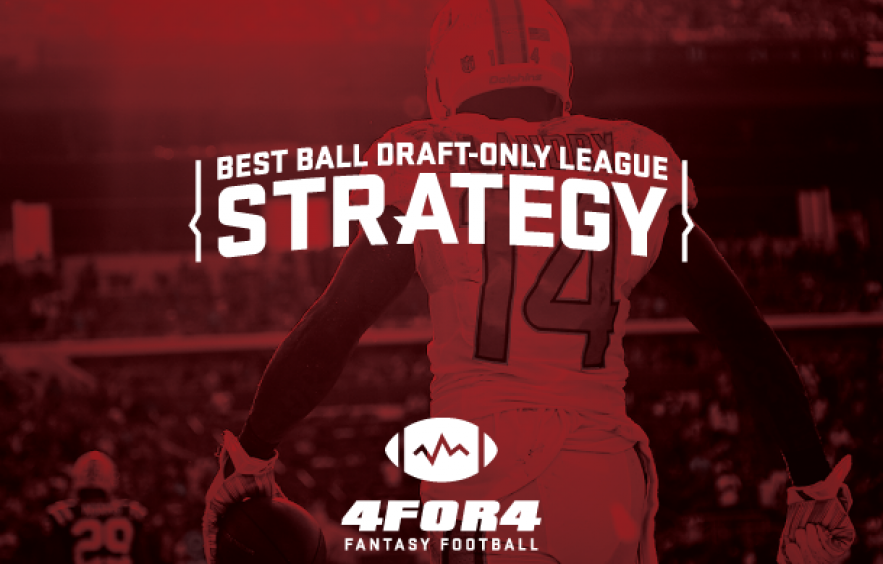
Best-ball contests have exploded over the past few seasons, in part due to their easy draft-and-go formats, along with the ability for the fantasy football community to partake ridiculously early in the NFL offseason. MFL10s have been the go-to option for best-ballers in recent years, but DRAFT has recently risen in popularity. Like shopping for the best values across DFS sites, comparing ADP between the two most popular best-ball platforms is a great way for owners to find value on their favorite players throughout the offseason.
Before making ADP comparisons between the two sites, we need to lay out the contrasts in scoring in order to get a true idea of why players are being selected where they are. Scoring for best ball contests on both sites is fairly simpatico, with just a few tweaks. One main difference is that DRAFT does not utilize a team defense at all, using 18-man rosters for QB, RB, WR, and TE while MFL10s have 20-man teams including the use of a DST. DRAFT also implements half-PPR scoring with MFL using a full-point PPR format. QB scoring also differs a bit and will be addressed a tad later in this piece.
When taking a look at the ADP data for the bulk of March, we can see that drafters for both MFL (which has been taken over by Fanball) and DRAFT are fairly consistent when it comes to the apex guys, players who are being taken in the first round. RBs have dominated round one with Todd Gurley emerging as the top Dawg on both sites (yes, that’s a UGA pun—I can never abandon my blatant homerism.) LeVeon Bell has been the RB2 and overall second selection, with Ezekiel Elliott, Alvin Kamara and David Johnson fluttering between the third and seventh spots. Sophomore Kareem Hunt holds both DRAFT and MFL10's eighth draft slot as RB6, with fellow second-year rusher Leonard Fournette coming off the board at the end of the first-round as RB7. No surprise here, but Antonio Brown has a firm grip on WR1, as MFL10’s sixth overall pick and DRAFT’s fifth.
Quarterbacks
QBs are being selected where they should be at this point, as far as not going too early in the draft process, yet the top guys are seeing a decent variance between the two sites. DRAFT users are grabbing the top six signal callers an average of 21.2 spots earlier than MFL users, which one would think could be a reflection of their scoring disparities. However, MFL awards .05 of a point per passing yard to DRAFT’s .04, with MFL taking 2 points away for a pick, while DRAFT snags only one point per interception. The difference could stem from DRAFT’s tendency to rank their QBs higher overall, but it’s just too early to really tell the reasoning for the sizeable discrepancy.
Running Backs
An interesting trend I noticed is that the ADP of RBs as a whole is more consistent among the two sets of drafters than any other position player. There are 24 players whose ADP variance is one or zero between MFL and DRAFT—13 of those are RBs and nine are WRs, with one TE and one QB. It appears that despite the differing draft strategies out there, RBs are being taken at very close to the same ADPs by both sites’ users. Here’s a look at the players who fit the bill here, and where they are falling in the drafts.
| Player | Team | DRAFT ADP | MFL ADP | +/- |
|---|---|---|---|---|
| Derrick Henry | TEN | 25 | 24 | -1 |
| Chris Thompson | WAS | 72 | 71 | -1 |
| Doug Martin | OAK | 162 | 161 | -1 |
| Todd Gurley | LAR | 1 | 1 | 0 |
| LeVeon Bell | PIT | 2 | 2 | 0 |
| Kareem Hunt | KC | 8 | 8 | 0 |
| Jordan Howard | CHI | 26 | 26 | 0 |
| Kenyan Drake | MIA | 33 | 33 | 0 |
| Ezekiel Elliott | DAL | 3 | 4 | 1 |
| Leonard Fournette | JAX | 10 | 11 | 1 |
| Melvin Gordon | LAC | 11 | 12 | 1 |
| Mark Ingram | NO | 19 | 20 | 1 |
| Chris Ivory | BUF | 239 | 240 | 1 |
Not all RBs have been selected at a consensus ADP however, as this offseason's backfield carousel leaves many question marks around the league. Jerrick McKinnon in a 49ers uniform has MFL drafters grabbing the former Viking 25 spots before those on DRAFT, while San Francisco sophomore Matt Brieda is hotter among DRAFT users by 32 slots. With Frank Gore out of the picture, Marlon Mack should see starter carries in Indy but is currently sitting as RB28, with an ADP difference of 37 between users on both sites. While Jordan Howard is sitting firm as RB15, his Bears' teammate Tarik Cohen is experiencing a wide variance as RB32. MFL players are taking the rusher 18 places before those on DRAFT, perhaps due to the uncertainty of his role in Chicago's new Matt Nagy led offense. The table below showcases some more RBs with the most disparity throughout best ball drafts in March.
| Player | Team | DRAFT ADP | MFL ADP | +/_ |
|---|---|---|---|---|
| Jerick McKinnon | SF | 105 | 80 | -25 |
| Aaron Jones | GB | 108 | 83 | -25 |
| Latavius Murray | MIN | 133 | 165 | -22 |
| Tarik Cohen | CHI | 102 | 84 | -18 |
| Giovani Bernard | CIN | 143 | 132 | -11 |
| Chris Carson | SEA | 95 | 117 | 22 |
| Ameer Abdullah | DET | 164 | 190 | 26 |
| Latavius Murray | MIN | 133 | 165 | 32 |
| Matt Breida | SF | 148 | 180 | 32 |
| Marlon Mack | IND | 85 | 122 | 37 |
| Bilal Powell | NYJ | 97 | 137 | 40 |
Wide Receivers
When it comes to constructing best ball rosters from March 2–28th, WRs have by far the highest variance between MFL10 and DRAFT users so far. Looking at players whose ADP differs 20 spots or more, with DRAFT being the lower ADP of the two, there are currently 19 WRs who fall in that range—that large swing in ADP may be explained by the fact that an extra half point per reception is awarded in MFL10s over DRAFT. On the flip side, there are 20 WRs who are being drafted at least 20 picks later on DRAFT than in MFL10s. Below you'll find a chart with every wideout whose ADP was greater than 20 spots across both draft sites.
| Player | Team | DRAFT ADP | MFL ADP | +/- |
|---|---|---|---|---|
| Albert Wilson | MIA | 252 | 196 | -56 |
| Taylor Gabriel | CHI | 270 | 219 | -51 |
| Ryan Grant | IND | 267 | 227 | -40 |
| Kenny Stills | MIA | 137 | 99 | -38 |
| Jermaine Kearse | NYJ | 205 | 168 | -37 |
| Emmanuel Sanders | DEN | 123 | 88 | -35 |
| Marqise Lee | JAX | 129 | 95 | -34 |
| Tyrell Williams | LAC | 202 | 169 | -33 |
| Josh Reynolds | LAR | 297 | 266 | -31 |
| Kelvin Benjamin | BUF | 132 | 103 | -29 |
| Randall Cobb | GB | 135 | 106 | -29 |
| Tyler Lockett | SEA | 195 | 166 | -29 |
| DeSean Jackson | TB | 159 | 131 | -28 |
| Pierre Garcon | SF | 120 | 93 | -27 |
| Larry Fitzgerald | ARI | 60 | 39 | -21 |
| Sammy Watkins | KC | 87 | 66 | -21 |
| Demaryius Thomas | DEN | 68 | 48 | -20 |
| Julian Edelman | NE | 81 | 61 | -20 |
| Jamison Crowder | WAS | 98 | 78 | -20 |
| Sterling Shepard | NYG | 116 | 96 | -20 |
| Chris Hogan | NE | 101 | 121 | 20 |
| Dede Westbrook | JAX | 128 | 149 | 21 |
| Corey Coleman | CLE | 153 | 175 | 22 |
| Mike Williams | LAC | 165 | 187 | 22 |
| Cameron Meredith | CHI | 144 | 167 | 23 |
| Allen Hurns | DAL | 182 | 210 | 28 |
| Mack Hollins | PHI | 262 | 290 | 28 |
| Brandon Marshall | NYG | 222 | 252 | 30 |
| Mike Wallace | PHI | 176 | 208 | 32 |
| Zay Jones | BUF | 183 | 217 | 34 |
| Geronimo Allison | GB | 255 | 291 | 36 |
| Malcolm Mitchell | NE | 261 | 301 | 40 |
| Trent Taylor | SF | 224 | 267 | 43 |
| Tyler Boyd | CIN | 294 | 342 | 48 |
| Willie Snead | NO | 251 | 312 | 61 |
| Kevin White | CHI | 223 | 288 | 65 |
| Curtis Samuel | CAR | 217 | 287 | 70 |
| Jakeem Grant | MIA | 254 | 332 | 78 |
| John Ross | CIN | 211 | 308 | 97 |
WR is always a tough segment to figure out this early on, with some teams still searching for their starting QB, which is why drafting in March/April is always a risky endeavor. Degenerates are going to degenerate, so here’s some more interesting info that this early data has shown.
Tight Ends
As usual, TEs are all over the board with drafters deciding to implement so many different strategies with the position. After the top tier of players, the variance becomes sizable between drafters on both sites, starting with Greg Olsen. Rumors of him hanging up the cleats for a booth job may have an impact, but his ADP is a 20-point swing with DRAFT users taking him earlier. With Tampa Bay re-signing Cameron Brate this offseason, the top two TEs on Tampa's roster have seen their ADP shift in opposite directions. Brate is being selected 17 spots earlier than O.J. Howard in MFLs, while DRAFT's data shows Howard favored by 21 spots. Guys with new homes are also seeing substantial variances such as Eric Ebron and Trey Burton whose ADP contrasts across sites are 21 and 27 picks, respectively. This table showcases these and other notable TEs whose draft spots have shown considerable disparity so far this best ball season.
| Player | Team | DRAFT ADP | MFL ADP | +/- |
|---|---|---|---|---|
| Trey Burton | CHI | 166 | 139 | -27 |
| Cameron Brate | TB | 146 | 129 | -17 |
| Greg Olsen | CAR | 49 | 69 | 20 |
| Eric Ebron | IND | 106 | 127 | 21 |
| O.J. Howard | TB | 107 | 128 | 21 |
| Tyler Eifert | CIN | 122 | 152 | 30 |
| Charles Clay | BUF | 136 | 170 | 34 |
Teams to Monitor
Nobody knows what to think about or what to do with Miami’s receiving corps. Firstly, QB Ryan Tannehill, who is being selected as QB27 on DRAFT, currently has a 54 slot change in ADP between the two sites and is the QB32 in MFL10s. Owners on DRAFT are grabbing him much earlier than MFL players while his wideouts are all over the place. Devante Parker is the earliest to go as WR40 on both sites, while Kenny Stills holds the WR53 slot on DRAFT but is the WR 44 in MFL10s. Former Chief Albert Wilson is being selected as WR81 on DRAFT and the WR 73 in MFL10s, while Jakeem Grant, just two WRs below Wilson is seeing a huge disparity, with DRAFT users grabbing him 78 spots before those in MFL10s.
New England is another head-scratcher, but that comes with the whole “Belichick mystique”. Rob Gronkowski is the TE1 on both sites, but despite the advantage in PPR on MFL, is being drafted 12 slots earlier in DRAFT contests. His teammates in the backfield are also experiencing wide variances in their ADPs, but that’s to be expected with a crowded and always infuriating depth chart at RB for the Patriots. Rex Burkhead is their first rusher off the board as the RB29 on DRAFT, followed not so closely by James White as RB46; Mike Gillislee and Jeremy Hill check in at RB65 and RB67, respectively.
Once the NFL Draft has come and gone, not only will all of us on twitter rejoice at not having to read about hand sizes, wingspan, and the like anymore this year, but we will have a better idea of how team’s offenses will shape up this season. This should have a large impact on best ball ADP heading into the summer, and will no doubt shake things up in a fun way.
Hold on to your hats, bandanas, beanies or whatever headdress you prefer, as we’re just getting started around here. Spring is in the air, and so is the beginning of tons of exciting fantasy football content at 4for4.



